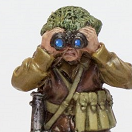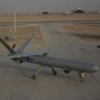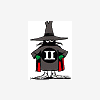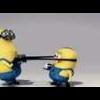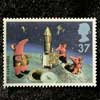Search the Community
Showing results for tags 'hawk'.
-
Hi All, As a stop gap between more detailed modelling projects, I decided to do a straight OOB build of the Italeri Hawk, because who doesn't need a Red Arrows aircraft in their collection. I'm having some issues with the front seat positioning. The mounts seem to force the seat into the wrong positioning. Has anyone else made this kit that can perhaps give me some pointers, or even photos of how they did it? All the builds I've found have been hit by the Photobucket money grab issue. (please excuse the current paint job. Just getting some base colours on and was dry fitting and discovered this issue). Notice the front seat area has mountings angled down towards the front. The rear one has less mountings and they are horizontal. Position 1, Clearly not right, placed on the higher step. position 2, doesn't seem right either. Placed on the lower step, it seems too far forward. I can't get the seat flush with the back vertical section, and the base horizontal mounting section because they're not at right angles to each other, but the seat is. Please help!!!
- 6 replies
-
- 1
-

-
- Hawk
- Red Arrows
-
(and 1 more)
Tagged with:
-
HobbyBoss is to release a 1/48th family of BAe Hawk. - ref.81733 - BAe Hawk T.Mk.1A - ref.81734 - BAe Hawk T.Mk.67 - ref.81735 - BAe Hawk T.Mk.100/102 - ref.81736 - BAe Hawk T.Mk.127 - ref.81737 - BAe Hawk Mk.200/208/209 - ref.81738 - BAe Hawk T.Mk.1/1A Red Arrows Source: http://tieba.baidu.com/p/2804569608 V.P.
- 70 replies
-
Not only made in Britain, but in my opinion the best of Britian. Flying the Red, White and Blue all over the world since 1965 the Red Arrows are perhaps the premier aerobatic teams in the world and are great ambassadors for the United Kingdom. After a disastrous end to my last build I hope to make a better job this time around. I will be building both models from the Airfix 1/48 scale 50th Anniversary box set.
- 12 replies
-
- 4
-

-
- Red Arrows
- Gnat
-
(and 1 more)
Tagged with:
-
Hello, someone can tell me what color was the flap vane? Especially on the RAF Hawk T.1 with the dark sea grey/dark green wraparound camouflage. Should be dark green as for the flap... or zinc chromate? CIAO! Piero
-
Hi Folks, This is the build that nearly broke me, everything that could've gone wrong went wrong. I bought this kit on flea bay ages ago for a song. It comes with demonstrator or Australian AF schemes. I decided I wanted a Hawk T2 from Xtradecal's excellent 4 sqdn package....................this is where my problems began. Looking at a T2 walkaround I saw that the wing fences on the kit were unlike those on the T2, so more daption and scratch building the fuselage halves didn't fit well and required much filling and sanding to get a good fit........................then you find you should have fitted the tail pipe before closure so you split your flawless work to insert it !!! Undercarriage doors were also a major problem, they are too thick to fit together so I replaced with plasticard. The final insult came when I went to fit the canopy, when the blast screen was fitted the canopy would not seat properly, hence the open canopy(showing the poor interior that wasn't meant to show Believe me this model nearly actually 'flew' on a number of occasions. On the plus side I learned a lot and the supplied stencils were very sparse !!! Cheers, All comments welcome PS: I just noticed the tail fillet is wrong too !!!!
- 20 replies
-
- 29
-

-
Hi Guys Have has a complete brain fad, i am sure there is or has been a reference to a Hawk Sig, but can't for the life of me where to look.I spent 20+ years looking after the Export customers of the Hawk. Thanks again in advance for any help or pointers ATB Jim
-
1:72 Airfix 2012 Union Jack Hawk T1 Jubilee
bangle posted a topic in Ready for Inspection - Aircraft
This a model we made for my sister as a birthday present. My husband did most of the work, I did the interior and we both made the glass case. The only decals we used were the stencils and insignia. My husband made the paint masks himself for the scheme using a scale-checked scan of the decals.- 17 replies
-
- 24
-

-
1:32 Hawk T-1 lighting kit Tirydium Models Following on from his fibre optic lighting sets for sci-fi subjects HERE, Tirydium Models has released this set for the Revell 1:32 BAe Hawk T-1. Packaged in a clear zip lock bag the set comes complete with all you need to light the following: Nose Light (White LED) Wing Tip Warning lights, (White LED’s with 2 x 0.75 fibre guides) Top Strobe Light, (Red LED with 1 x 1.0mm fibre guide) Underside Strobe Light, (Red LED with 1 x 1.0mm fibre guide) There is also a controller chip on a board for the flashing strobe lights. Everything comes pre assembled, so all the modeller has to do is fit the parts into the model as it’s being built. Due to the construction of the kit slots will need to be filed out along the wing for the fibres to fit without being pinched and the wing tip lights will require their lugs cutting off and a small hole drilled into them. The instructions are very clear and easy to read and come with a selection of colour photographs showing where and how the LED’s and fibres are to be installed, along with written instructions explaining what needs to be done. The kit is well made with all LED/Fibre optic joints well taped up, there may be a slight excess of fibre for the lights, but this can easy be cut to size. Conclusion This is a very nice and well made set-up for those who either don’t feel competent or, like me, a little too lazy to fit lighting systems to their models even though they would like to. With this kit, aided by the clear instructions, there is now no excuse. Highly recommended. Review sample courtesy of
- 8 replies
-
- 1
-

-
- Lighting
- Fibre Optic
-
(and 3 more)
Tagged with:
-
I am building a BAe Hawk of the Finnish AF, using the Tamiya 1/48 Hawk Mk.66 "Swiss Air Force" kit (89784). The kit ejection seats don't look TOO bad, other than no seatbelts, but I am wondering which of the following aftermarket ejection seats would be the most accurate: Pavla Models PAVS48020 - Martin-Baker Mk.10A Pavla Models PAVS48027 - Martin-Baker Mk.10H I already have the VICON recce pod and the Russian missiles that the plane will be carrying. Larry
-
Completed 1/72 Airfix 50th Anniversary Red Arrows Hawk T1, with Eduard etch. Dave
-
Hello one and all, Kit manufacture: Airfix Scale: 1/72 Type: British Aerospace Hawk T.Mk.1, No.208 ® Squadron, Royal Air Force Valley, 2009 Extras used: none straight out of the box Paints and colours used: Vallejo model air black and gloss varnish Other info: I've just finished putting together this little diorama for the RAF BF Hawk, I enjoyed building the kit, quite happy with it even though it is no way near the standard of most models on the forum. The kit went together nicely apart from the undercarriage doors aren't flush with the rest of the fuselage and wing. 20160902-03.jpg by Neal, on Flickr 20160902-05.jpg by Neal, on Flickr 20160902-06.jpg by Neal, on Flickr 20160902-07.jpg by Neal, on Flickr 20160902-08.jpg by Neal, on Flickr 20160902-09.jpg by Neal, on Flickr 20160902-11.jpg by Neal, on Flickr 20160902-12.jpg by Neal, on Flickr Thanks for looking, any feedback is welcome.
-
Yet another ebay impulse buy occurred last Saturday following a few pints and it arrived today. The new tool Revell Hawk. This rather neat little kit comes trying to be a modern hawk with 2015 Reds decals however it has the old style curved rear upper fuselage. Now this gave me an idea, make it into a very early hawk. As early as it comes, the prototype XX154 as it was when it first flew in 1974, looking something like this:- http://www.airport-data.com/aircraft/photo/001133060L.html The Revell offering will need a bit of modification, but not a lot. So things I know I need to change are as follows Wing fences moved inboard and reshaped, - Plasticard Absence of vortex generators. - wet & dry Wide ejection seat head boxes - Scratch built or modified old matchbox seat Fritag style So far I cant see any other changes needed. This sounds far to simple to be true so.... Anyone know what else is needed?? Thanks for looking CT
-
I honestly don't know how long this has sat on the shelf of doom, and for the simple reason that the fin decals were a tad too short and, on some of the lower arrow decals the wrinkling from Microsol/Microset hadn't fully pulled out. Anyway with a spare few hours and needing a break from the Junglie, I decided to try and wrap this up. I used fin decals from another of these kits in the stash to fill the gap at the top of the fin. The decal wrinkling, well there wasn't much I could do with that to be honest so I thought, to hell with it lets just finish this. Here it is decalled, the artificial light has given it a very pink tinge in the first pic, it's really not I promise - Mounted and in better light!! It's literally just stuck into a 2" x2" block of wood just now, I'm planning a better base for it than this, and a slightly different pose - Used a cut down pin for the pitot probe, and it makes a huge difference. The smoke is just cotton wool teased out and stuck to a steel 1.3mm rod, then sprayed a thinned blue colour. The rod goes all the way through the aircraft and stops in a hole on the rear cockpit bulkhead making it pretty stable once stuck in place with some Gator Glue. Hope this appeals to the masses. I'll post some more pics once the new base is done. Rgds, Eng
- 15 replies
-
- 28
-

-
Hawk T.1 for Revell Kit 1:72 Eduard The new Revell Hawk as reviewed here is a good kit in its own right, now Eduard have followed up with a PE update set. This arrives as one nickel fret and one brass fret. The frets provide details for The Ejection Seats (including belts), all instrument & side panels, Jet pipe, undercarriage doors, undercarriage bay parts, wing fences, smoke pipes for the Red Arrows, fuselage plates, and canopy fittings. Conclusion These parts should enhance an already good kit. Recommended. Review sample courtesy of
-
Hawk as used by the Red Arrows. Pic from Graham James.
- 1 reply
-
- Hawker Siddeley
- Hawk
-
(and 1 more)
Tagged with:
-
Pro-Resin (Olimp) is to release a Curtiss P-1 Hawk resin kit - ref. R48-003 Source: http://www.olimpmodels.com/catalog_2.html V.P.
-
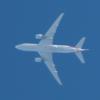
1/72 Airfix BAE Hawk T.1A Royal Navy
Darren Rhodes posted a topic in Ready for Inspection - Aircraft
Greetings folks, Last of what I can term my shelf of doom builds. Sadly this one is somewhat worse for wear for its time on the shelf of doom, owing to the fact that is departed said shelf on at least one occasion, doing damage to many of the sticky out bits. That being because this has stood on the shelf of doom awaiting merely a canopy for several years. A canopy I say, however, at the fifth attempt, you read that right on the fifth canopy I considered it passable to consider complete. I won't say any more about my masking skills. And not looking forward to my explaining my request for three canopies to Airfix (received one replacement so far). What with Fritag's stunning Hawk build I honestly wasn't going to post this, but I think I've fixed one thing that Fritag will miss, Royal Navy markings! That and I'm feeling sympathetic to the Navy folks on here who I have observed seemed to get picked on somewhat. Airfix kit, I think Model Alliance decals, Pavla resin seats and a Master pitot probe, other out of the box. Painted with Xtracolour enamel black, only way I can get a glossy finish. On with the photos. Darren- 29 replies
-
- 46
-

-
I have finished my group builds in the P-38 and Sci-Fi, albeit about a week after each was due. (Planning and execution is everything!) I have decided to do something different. I have seen many fine people with far better building skills than I tackle modifications of kits and turn out breath taking models. I am still trying to just become adequate at making a kit look like a decent model out of the box. But, I figure if I ever want to expand my horizons, I need to get outside of my comfort zone and do something different. So, here is my hair-brained scheme. I have the 1/48 Hawk Lysander kit that was initially released in 1968. And from one of my strange aircraft reference books I have this wonderfully odd picture. That there is a Westland P.12. It is a modified Lysander that was to be used to strafe beaches and landing craft should the Nazi invasion occur. Now, for some reason, I think I can convert this Hawk kit to a P-12 and scratch all the conversion parts. Pretty optimistic huh? All it is going to take is a new rear fuselage, two baby wings at the rear, 2 rudders and a gun turret. How hard can that be? I guess I will find out. The kit is very simplistic, with a sparse interior. There are not many parts. Might as well plunge in before I lose my nerve. I don’t really have a great plan of how to do this, so most of the conversion will be worked out about 5 minutes before I start building it. I choose as my first step to build the wheels. Not a really good reason why the wheels, but it is as good a place to start as any. Each lower wheel spat is built. And some work will have to be done on them. First, at the front of each spat I will have to drill a hole and construct some sort of search light. But before I do that, I need to eliminate the attachment points for the mini-wings that fit on the spats and where the 20 lb. bombs go. On the first spat, I get a little too enthused with the sanding process and break through the plastic just a smidgeon. Milliput will have to come to the rescue. On the other spat, I am a bit more careful. While the glue and milliput dry on the wheel spats, I get the fuselage halves ready to glue. There are a couple of injection towers to eliminate. Once the injection towers are sorted a one piece section that will house the pilot and observer seats is placed in the starboard fuselage half and the port half is joined to it. I thought it might be easier for me to glue the fuselage halves together and then construct the new rear fuselage than to try and do a right half and left half modification. While the fuselage dries prior to me hacking on it, I construct the wings and attach them to a center canopy section Next up I tackle a very simple but quite nice little engine. By this time, the fuselage is dry enough to try to figure out where to cut it in two. After studying the very limited amount of photos for this plane, it looks like the modified fuselage section was added where the rear gunner would sit in a regular Lysander. Taking my marker, I place where the cut should be . . . And then hack away with my saw and I am now committed to this project. From looking at photos, the rear fuselage plug looks to be a one size portion with the same shape from the canopy back to the gun turret. In my simple head, I think a one size internal support can be duplicated and then some plasticard will be used to skin around the supports. Sounds easy-peasy in my head. Now let’s see how reality works. I take some light plasticard stock and trace the outline of the fuselage section that I have left. I cut that out and then make a half plug. This half plug is then traced on some paper card stock so I have a somewhat symmetrical internal support. The card stock pattern is then checked against the fuselage to see if I am somewhat close. Using the card stock pattern, I cut out 4 plasticard supports, put them together and then sand them to match each other. I then tape them together as I have the slightly mad idea that four pieces of wire could be used to provide stable support system so that skinning the internal structure won’t be too much of a headache. Holes are drilled and wire is inserted. This might work. First problem though is the skin on the Lysander is not smooth. I have to match a rib pattern. RATS!!! Now how it that going to work. The only thing I can come up with is to score one side of the plasticard with some sort of semi sharp object so the opposite side looks like the Lysander skin. I experiment with different knives and scalpel blades and noting is coming close. I then look at my trusty screwdriver that I use to open Humbrol tins of paint and hmmmmm. . . . I get these results I think if I make the scores closer together this will work. My next step is to work out how long the rear section is to be and then make a bunch of scores with the same pressure. What could possibly go wrong with this plan? But, it is late and my hands are not the most steady right now. So I will end here and maybe go look at the 1/72 stash to find some donor wings for the rear fin assembly. As always, all comments are welcome.
-
Here I go again with another bout of madness and over ambition!! I recently picked up the Round2 re-release of the old Airfix/MPC Eagle from Space:1999. Space:1999 is still one of my all time favourite Sci-fi shows and the Eagle is one of my all time favourite craft. This is my third purchase of this model; the first was played with to destruction when I was about 7 or 8. Then the next one was much better looked after and that one came with it's companion: a Mk.XI Hawk. These two were built OK and then a few years later were lightly restored. I still have them both now and in fact I found them in the loft just after I picked up the Round2 kit. Then my head got started.... Thoughts of a Lab-Pod and Spine Booster and a winch pod... 2 Eagles and a Hawk on display with loads of additional goodies. So here we are. The new Round2 Kit - a re-release of the old MPC/Airfix kit. And the remains of my two old kits, both original Airfix releases from the mid to late seventies. Both quite badly finished. My intention is to build/re-build both Eagles simultaneously. The kit is not very accurate out of the box so my intention is to make as many modifications as is possible/sensible to make the kit more accurate whilst still using most of the kit; I've seen others improve this kit and they ended up discarding all of the kit - this is not my intention, just to make what is there a bit better, although I will be doing some scratch building to correct some areas and create the 'walkways' and shelves'. I also intend to build a variety of pods. The standard pod comes out of the box. I can make a lab-pod by modifying the other standard pod and I can scratch build a cargo winch pod. I also want to do the spine booster as seen in the episode 'The Metamorph'. The Hawk is quire accurate out of the box, however I'll clean it up and re-build it using today's modelling skills. I've got some other Space:1999 ideas, but this is enough for now!! Thanks for looking! Karl
- 20 replies
-
- 3
-

-
- space:1999
- eagle
-
(and 1 more)
Tagged with:
-
The Curtiss company sold aircraft all over the world in the twenties and thirties of the last century, but its greatest export success came in China, and was attended by intrigue and skullduggery which would not have been out of place in the 'Yellow Peril' tales so common in the pulp magazines of the day. Curtiss' first large sale to China, booked in spring of 1932, set the tone: 18 export Hawk I fighters sold, through an intermediary company, to a body in open rebellion against the internationally recognized central government of China. How there came to exist in 1932 two governments, one at Canton and one at Nanking, each claiming to be the Nationalist Party government of the Republic of China, is, I hope you will agree, worth some small digression. I assure you what follows is brutally compressed.... Dr. Sun Yat-sen and his Nationalist Party (Koumintang/KMT) made the revolution in 1911 that established the Republic of China, but were expelled from any share in governing it by Yuan Shi-kai, the premier general of the day. The good Doctor and his Party survived only by the patronage of local generals in the south who resented the dominance of the northerner Yuan Shi-kai. When Yuan died in 1916, and China entered the War Lord Period of conflict between generals for hegemony over the land, Dr. Sun Yat-sen and his Nationalists remained little more than pawns of military figures at Canton. To provide the Nationalist Party an army of its own, Dr. Sun sought assistance from the Soviet Union in 1924. Part of the price was alliance with the fledgling Chinese Communist Party. While the Communists focused on organizing laborers and peasants, the new National Revolutionary Army came into being, led by Gen. Chiang Kai-shek, a young revolutionary activist who had become Dr. Sun's counsel on military affairs. Dr. Sun Yat-sen died in 1925, and leadership of the Nationalist Party devolved on his old comrade Hu Han-min, with Chiang Kai-shek directing military affairs from his base at the Whampoa Military Academy near Canton. In the summer of 1926 Gen. Chiang Kai-shek led the new National Revolutionary Army on the epic Northern Expedition, engaging in turn and defeating (or co-opting) the various war lords controlling eastern and northern China. In the course of this open hostilities broke out between Chiang Kai-shek and the Communists, with much of the political and intellectual leadership of the Nationalist Party caught in the middle. Chiang's final victory in the north was greatly assisted by a populist war lord, Gen. Feng Yu-hsiang, but once Chiang had secured allegiance to his government at Nanking from his last remaining opponents in Manchuria, in 1930 he turned on Feng with assistance of troops from Manchuria. When Chiang Kai-shek placed Dr. Sun's old comrade Hu Han-min under house arrest early in 1931, generals in Kwangtung and Kwangsi provinces joined remaining leftist Nationalist political leaders in opposing Chiang's dominance of the Party and the country, led by the commander of the Canton garrison, Gen. Chen Chi-tang. He declared a new 'National Government' existed at Canton in June. Chiang at Nanking was unable to move immediately against this combination of Kwangtung and Kwangsi, as his forces were deeply involved against Communist guerrillas, but that summer it was clear civil war impended. Japan's invasion and occupation of Manchuria, begun with the Mukden Incident of September 18, 1931, made it politically impossible for Nanking and Canton to come to open blows, and Chiang's decision not to resist Japan militarily gave the Canton government grounds to assail him in the name of national patriotism. The purchase of 18 Hawk I pursuit ships by the Canton government was no trifle: when the order was placed in May, 1932, these were greatly superior to any aircraft the Nanking government possessed, though by the time delivery to Canton commenced in July, 1933, Nanking had placed an order with Curtiss for some 32 similar Hawk II pursuits. The radial engined export Hawks were broadly similar to the F11C-2 'Goshawk' going into service with the U.S. Navy early in 1933, but differed appreciably in detail, being little more than P-6Es with a radial motor replacing the glycol-cooled Conqueror V-12 employed by the U.S.A.A.C. pursuit already in service some years. The Curtiss Co.'s operations in China from the start of 1933 were in the hands of an extraordinarily lithe and ruthless fellow, one William Pawley. It was he who sold the Nanking government its first Hawk pursuits, and the following year, even as that order was still being completed, he was negotiating with the Canton government to build an aircraft factory on its territory, to assemble both Vultee and Curtiss designs. He went on to sell new Curtiss machines to both Canton and Nanking, with Canton beginning to receive parts for assembly at its new factory early in 1936. By then Gen. Chiang Kai-shek, having driven the Communists to the northwest fringes of China, was concentrating troops in the south. In May, 1936, the old revolutionary Hu Han-min died, and with him went most of the political legitimacy of the Canton government. Gen. Chen Chi-tang at Canton re-christened his forces as 'The Anti-Japanese Salvation Army' and set out in June marching northwards. Little enthusiasm was displayed, and the matter was brought to an end by the defection en masse on July 18 of the Canton Air Force, whose pilots flew their equipment, including fourteen or fifteen Hawk I pursuits remaining serviceable, to fields controlled by Nanking loyalists. Two days latter Gen. Chiang Kai-shek's soldiers were in Canton itself. The aircraft and personnel of the Canton Air Force were incorporated into the Chinese Nationalist Air Force, maintained as a separate unit. Its men were never completely trusted by Chiang --- after all, they had show themselves capable of turning on their leader, and for all the use Chiang made of suborning betrayal, he himself valued loyalty above all else, even competence. The Hawk pursuits purchased by Canton which still survived when open war commenced between Imperial Japan and Nationalist China in July, 1937, were expended in combat over northern China, mostly against Japanese Army fighters. The visible differences between the radial engined export Hawk and the Navy F11C-2 are considerable. The Goshawk had extended landing gear legs, a turtle-back behind the cockpit incorporating the headrest, and a tail-wheel at the stern-post with a cut-out in the rudder to accommodate a shock absorber. The export Hawk I (and Hawk II) retained the original landing gear, separate head-rest, and rudder of the P-6E, though it did employ a simple tail-skid rather than a tail-wheel. Accordingly, this model is a blend of several kits. It is basically an old 1/72 Monogram Goshawk kit, but it has grafted onto it the rear fuselage of a Monogram P-6E kit (remains of an Accurate Miniatures re-issued 'double'), while the motor, landing gear, slipper tank, rudder, and decals, as well as much cockpit detail, comes from an RS Models Hawk kit. That I have chosen to treat the RS kit as a sort of 'detail pack' in this build should not be taken to indicate I think the RS kit is a poor one; it most definitely is not. Among its virtues is that it is the only kit I have yet seen that does a decent job of replicating the general arrangements of a Curtiss biplane cockpit. It does, however, have some noticeable differences in dimension from the Monogram kit, in wing chord and fuselage height; I do not know which is right, mind, but I have built up several of the Monograms, and prefer their leaner look. One thing the RS people definitely do get wrong, however, is attributing the plane they provide Chinese decals for to the Kwangsi Air Force. Kwangsi never bought any Curtiss machines, and the markings they provide definitely are for a Canton machine. The red ring around the 'sun in the sky' was the original Nationalist marking, which the Canton and Kwangsi aircraft maintained down the several years of independence. I also think it is incorrect to indicate the machine is painted in aluminum dope. Photographs of Canton Hawks show a deeper grey tone than usually associated with aluminum finishes, and Boeing 281 pursuits delivered not long after the Hawks were painted an overall pale grey. I have finished this model accordingly. I have been informed that 'the characters on the side read (in standard Mandarin pronunciation) Guangzhou Shi Xiao Hao, which is ambiguously 'School [of] Guangzhou City' or 'City School [of] Guangzhou', so their meaning would seem to be that the machine was paid for by funds collected from or by a university or university students in Canton. On edit, 25/8/15: I feel rather dim; I called this done before it actually was. The project had sat on the shelf a good while, hovering just short of completion, and I guess I lost the thread a bit. When wife got back from hospital last month, after an extended stay (long story...), and I could relax and start at least a little modelling, I picked this as one to finish. But I noticed looking back at these pictures I had neglected a few wires on the tail assembly. They are on now, and here are a few fresh shots to repair the omission....
- 19 replies
-
- 22
-

-
I built this after seeing a profile over on the Claveworks Graphics site. The Airfix 1/72 Hawk 100 kit was used, as I felt the nose looked more F1-ish. Built pretty much OOB except for the decals, which I made myself.
- 34 replies
-
- 68
-

-
With some trepidation, my first RfI... I got back into modelling fairly recently; this is my first 'try and get a reasonably decent result' build, as well as an opportunity to try out airbrushing. I had a lot of trouble with the decals. Not long after doing them I saw a post from someone else here building this kit (or what I assume is the reboxing of it with the Gnat) who commented about how bad they were, so I was relieved it wasn't just me. Thin and fragile, and came out pale and rather speckled, and the less said about the ones for the underside arrow the better. Efforts to patch up with white paint only showed up the problems more... Other lessons learned included making sure I had a proper fit. I ended up with slightly down-bent wings that needed straightening, but that left me with a lot of problems getting the intakes to fit. Built OOB, except for two Pavla Mk 10 seats as I wanted to build without aircrew in the cockpit. Oh, and the pitot tube is replaced by a pin - even that is far more realistic looking than the plastic part supplied! Painted in Humbrol Arrow Red and finished with several coats of Humbrol Clear for the right gloss finish.
-
My latest completion is the Airfix Curtiss Hawk, WiP here. A nice easy build with only a few fit problems on the nose. Build to the standard AVG Flying Tigers scheme painted with Vallejo Model Air and my first use of Humbrol Dust wash (I like it). Thanks for looking.
- 20 replies
-
- 27
-

-
Built as a bit of fun, I added CMK resin seats, and it's not exactly finished (missing details, like the canopy MDC cord, I'm still waiting for inspiration). Photographed complete with chequered tablecloth and plant pots background - but built in two weeks while waiting for parts for my STGB Phantom. This kit was free from Lucky Model HK as it was in a redemption offer if you spent over £75. Mad, but I wasn't going to miss that, as i was spending my Christmas money anyway. Pretty nice kit, better detail than Revell's. Fits together about the same as Revell. The kit decals are absolutely fantastic, best I've ever used from a kit. Painted with Xtracrylix and Revell Aqua Gloss Black. Probably the easiest paintjob ever. The whole build was a very nice diversion and I really enjoyed it. It also looks very eye-catching and doesn't take up too much space for a 1/32 jet. It's also the first Aussie plane I've ever made. A nice build like this helps obsessives like me remember what modelling is really about! Al
- 6 replies
-
- 14
-

-
- Kinetic 1/32
- Hawk
-
(and 1 more)
Tagged with:
-
The Curtiss Hawk 75 was developed as a private venture by the Curtiss factory in the early 1930s. A number of versions with different engines and armaments were produced for different countries. By September 1939 the Dutch government had speeded up the modernization of its air force and ordered the Hawk 75A-7, which was equipped with the Wright-Cyclone R1820 1200hp engine. After the fall of The Netherlands, the planes were rerouted to the Dutch East Indies. The Hawks engaged Japanese invaders from December 1941 but were withdrawn from service in February 1942 due to engine issues. However, its more famous descendant, the P-40, served with much distinction in the Indies during and after the war. Since I’m on something of a Pacific Air War modeling spree, the P-36 / Hawk 75 has been on my list for some time. I’ve had the DB/Airwaves conversion nose in my stash for over 20 years, and I was always impressed by the quality of the part; it’s nicely detailed with recessed panel lines and flawless casting. The Revell/Monogram kit to be used for this conversion represents an A-4 and it’s old… raised panel lines, little interior detail, few parts. However, what’s there, is pretty good. Fit is decent and the transparencies are very clear. Installing the nose was a relatively simple job, but for some reason I misread the instructions, ignored common sense and used 2-component glue instead of CA to mate the new engine to the fuselage. This resulted in endless cycles of filling, sanding and priming. In the end I gouged out the 2-component glue and refilled with CA. I never did get the join quite right, but only I will notice (I hope). One issue caused by the nose job was that it removed the front on the cockpit. This resulted in a less than optimal mating surface for the windscreen, so this required some cutting, filling and blending. In turn, the sliding part of the canopy would not fit in the closed position, so I left it open. I added a QuickBoost gunsight and some tape seatbelts to spruce up the cockpit a bit. Since the nose has recessed panel lines, I decided to rescribe the entire kit. This was quite easy as there are only one or two curved panel lines, the rest are on flat surfaces. Even for me this was a relatively easy job – I’m useless at rescribing! Apart from the nose job, some other minor conversions were required. The Dutch planes only had the inner wing guns, so I removed the outer ones and the shell ejection chutes. Then I removed the inner ones as well as they are quite crude – and replaced them with Albion Alloys tubing. Same for the pitot tube. The propeller hub needed replacing as well as it’s the wrong shape. I cut off the original and replaced it with a reshaped piece of sprue. Finally, the Dutch planes had the lower portion of the gear doors removed, so this required some cutting and carving of the original parts. Painting was done with a layer of Tamiya fine primer followed by two coats of Games Workshop Runefang Steel, my NMF color of choice at the moment. It dries quickly and hardens very well, it’s easy to mask and does not pick up any nasty finger prints. The ailerons and elevators were sprayed in the same color with some grey mixed in to give a slightly faded look. Decals are from FlevoDecals ML-KNIL set 72012, which went down very well, as usual with decals from this manufacturer. I really like their sets, being a Dutch guy they are really indispensable to building my collection. I’m very happy with the final result; it’s a good-looking plane, and I’m very happy to have finally done this conversion, which has languished on the shelf for so long.
- 15 replies
-
- 17
-


